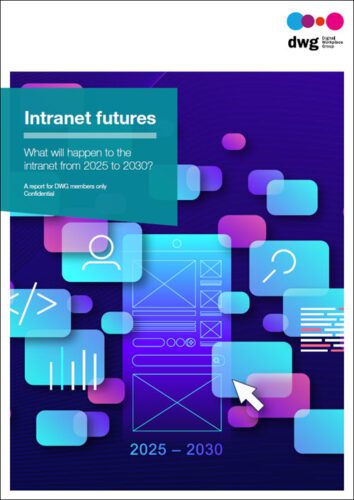Seven things we learnt about the digital workplace from the 2020 DWG survey
 Every year the digital workplace both changes and doesn’t change. The tools we use evolve and get more sophisticated; just two years ago perhaps we’d have been surprised to see the level of use of Microsoft (MS) Teams and that chatbots are starting to be so commonly used. At the same time, some of the common issues and conundrums, such as poor findability, the need to drive adoption and establish governance, don’t change fundamentally from year to year.
Every year the digital workplace both changes and doesn’t change. The tools we use evolve and get more sophisticated; just two years ago perhaps we’d have been surprised to see the level of use of Microsoft (MS) Teams and that chatbots are starting to be so commonly used. At the same time, some of the common issues and conundrums, such as poor findability, the need to drive adoption and establish governance, don’t change fundamentally from year to year.
This pattern of change and no change is what we see every year in the results from the DWG annual survey, a regular, detailed pulsecheck and snapshot of intranets and digital workplaces, carried out as part of DWG’s annual research programme. Completed by both DWG members and non-members, the responses reveal both surprising and less surprising trends.
Here are seven of the insights we gained about the digital workplace by crunching the numbers in the 2020 DWG annual survey.
1. MS Teams continues its march as Microsoft dominates in the digital workplace
MS Teams is reported to be Microsoft’s fastest ever growing business application and our survey certainly supports this view. Last year, an impressive 52% of organizations told us they used MS Teams for collaboration; this year that figure has grown to 69%. With over a third of companies also telling us they will be introducing or extending Teams in the next 18 months, the march of MS Teams seems likely to continue.
The use of MS Teams is just one way in which Microsoft and the 365 suite of tools are dominating the digital workplace, with survey responses also revealing very high use of SharePoint Online, Microsoft search, PowerApps, Power Automate (Flow), and more.
2. More organizations are setting up a formal digital workplace programme
Over the past three years the proportion of organizations telling us they have a formal digital workplace programme or function in place has been steadily rising, from 23% in 2018, to 31% in 2019 and 37% in 2020. This trend is also reflected in the SMG / DWG and aligns with the continuing interest we see in formal digital workplace initiatives across the industry.
We find this encouraging since a formal programme usually reflects healthy levels of investment, means the digital workplace is a strategic priority and shows joined-up thinking across stakeholders.
3. Digital literacy is being driven more and more by peers
Digital literacy is now regarded as a critical element of any digital workplace or digital transformation programme. A successful digital literacy initiative equips employees with the knowledge and confidence to use the new digital tools at their fingertips.
In our survey, we asked how teams are delivering digital literacy and training. The responses show an increasing use and involvement of peers in digital literacy programmes, often providing more local context for how tools are used and potentially driving more trust. For example, immediate colleagues tend to be listened to over IT functions.
Although “Online & classroom training” remains the most popular method, answers reflected a growth in the use of digital champions (34% in 2019, 52% in 2020), online communities (51% in 2019, 61% in 2020 ) and reverse mentoring (5% in 2019, 17% in 2020).
4. The majority of teams feel their digital workplace needs improvement
Anecdotally, most digital workplaces are a work-in-progress and, as most practitioners will tell you, there is always some work required to improve their digital workplace.
For the first time we asked respondents how effective they thought their digital workplace was. Unsurprisingly, the majority felt they still had work to do, with less than a quarter of all respondents rating their digital workplace as “very” or “extremely” effective. Although the majority feel there is work to do, only 7% felt their digital workplace needed a “total rethink”.
5. More teams are looking into deploying emergent technologies like microservices
Each year we ask about emergent technologies and organizations’ relative plans. For example, over the past couple of years, many digital workplace teams have told us they would be deploying chabots; in fact, so much so that in this year’s survey we decided chatbots could no longer be considered to be “emergent”.
Compared to last year, more and more organizations are planning to invest in new technologies such as sentiment analysis, robots, blockchain and microservices architecture. In particular, there has been a significant increase in the number of organizations planning to use microservices (0% in 2019, 36% in 2020), personal digital assistants (13% in 2019, 32% in 2020) and robots, with those declaring they are already using robots leaping from 6% to 28%.
Overall, the willingness to use more innovative technologies may reflect trends in easier deployment and the growth in the number of publicly available case studies, illustrating the possibilities and benefits of emerging tech.
6. Classic strategic priorities remain priorities
Managing intranets and digital workplaces involves a number of perennial issues that are remarkably consistent across different organizations and also remain consistent over the years. This year when we asked teams about their top strategic priorities, traditionally popular choices such as “driving adoption” (39%), digital workplace strategy (33%) and moving to a new platform (31%), again proved to be among the top five choices. Interestingly, there was some variation with a leap in “user experience” from 27% in 2019 to 38% in 2020, and a decline in search and findability (43% in 2019, 28% in 2020).
It is also interesting to observe what is not a priority. AI strategy is a top priority for just 13% of respondents while popular priorities from previous years such as “integrating social and collaboration features” are less important, reflecting the relative maturity of practices in this area.
7. Mobile access may have hit a plateau
Over the years, intranet mobile access for employees has improved, and each year our survey has reflected the progress made. While the number of respondents saying that the intranet is available on personal and corporate devices and is optimized is not dissimilar to last year (46% compared to 51%), it is the first time the numbers have fallen.
Similarly, for the first time, the number of organizations with no mobile access for their intranet has increased (13% compared to 7% last year), suggesting that the improvement in mobile access to intranets and digital services seen over the last few years may have reached a plateau.
Stay in touch with digital workplace trends
Trends in the digital workplace keep on emerging and here at DWG we will as ever be keeping an eye on what’s happening. If you’d like to stay informed, you can read our expert blog, tune into our Digital Workplace Impact podcasts and follow our 2020 research programme!
Take the next step…
Categorised in: Digital workplace, Digital workplace strategy

